Canon EOS-1D Mark IICanon doubles the resolution of their speed demon SLR, while actually increasing its speed and cutting image noise. Amazing!<<EOS-1D Mark II Sample Images :(Previous) | (Next): Print-Friendly Review Version>> EOS-1D Mark II Imatest ResultsReview First Posted: 01/27/2005 |
Detailed analysis of the Canon EOS-1D Mark II images, from Imatest(tm)
I've recently begun using Norman Koren's excellent "Imatest" analysis program for quantitative, thoroughly objective analysis of digicam test images. I highly commend it to our technically-oriented readers, as it's far and away the best, most comprehensive analysis program I've found to date. (And with an introductory price of only $59, it's hard to beat.)
My comments below are just brief observations of what I see in the Imatest results. A full discussion of all the data Imatest produces is really beyond the scope of this review: Visit the Imatest web site for a full discussion of what the program measures, how it performs its computations, and how to interpret its output.
Here's some of the results produced by Imatest for the Canon EOS-1D Mark II:
Color Accuracy
Overall, the Canon EOS-1D Mark II has very good to excellent hue accuracy
in its default color mode. Like most digital cameras, it tends to oversaturate
reds slightly, albeit not as much as some competing models do. In other parts
of the spectrum it's quite restrained, with relatively small amounts of over-
and under-saturation. (Slight oversaturation of blues and some greens, slight
undersaturation of yellow-greens and yellows, bright yellows showing the most
undersaturation.) On average, color saturation of swatches on the MacBeth
ColorChecker(tm) chart are 102.8% of their ideal values. (An average oversaturation
of 2.8%.) Average "delta-E" color error is 5.94, slightly worse
than the EOS-20D's level of 4.9, but still quite accurate.
Color Analysis
These images show the color behavior of the Canon EOS-1D Mark II more directly.
In each color swatch, the outer perimeter shows the color as actually captured
by the camera, the inner square shows the color after correcting for the luminance
of the photographed chart (as determined by a 2nd-order curve fit to the values
of the gray swatches), and the small rectangle inside the inner square shows
what the color should actually be, based on perfect rendering to the sRGB color
spacer. From this plot, we can see that while the 1D Mark II actually matches
most colors fairly closely, the primary deviation being that it tends to render
dark tones darker than their ideal values. (Default contrast is a little high,
but arranged in such a way that highlight values are preserved, most of the
tonal stretch being applied to midtones and darker.)
Gray Patch Tone and Noise Analysis
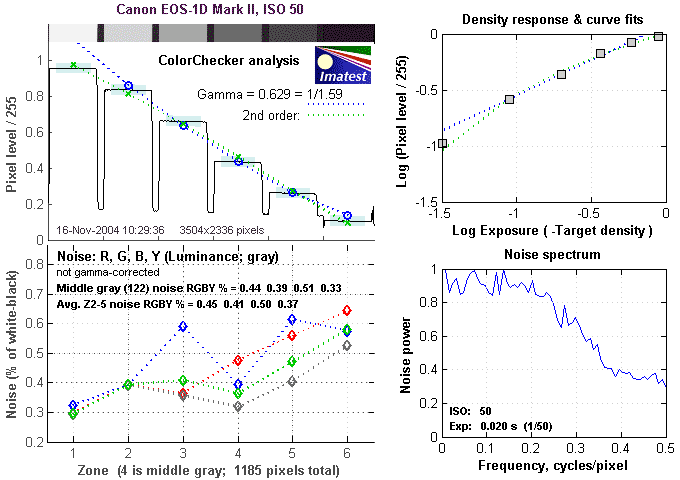
There's a lot in this particular graph, a lot more than I have room to go into
here. Bottom line, the 1D Mark II's noise levels are very low at ISO 50, and
its noise patterns have a fair bit of higher-frequency content (seen in the
way the lump on the left side of the frequency graph extends so far to the right).
From past experience, I've found Canon digital cameras to be notable for the
extent to which their noise spectra are pushed toward the higher spatial frequencies.
This produces noise with a very fine-grained character, that detracts much less
from the image quality than that of most other cameras on the market.
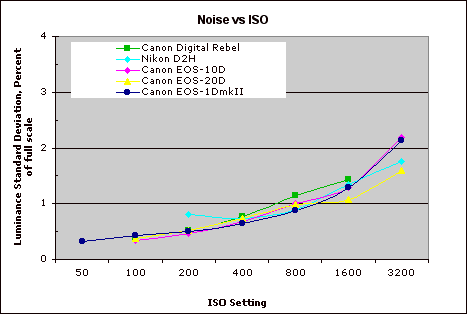
This chart compares the Canon EOS-1D Mark II's noise performance over a range
of ISOs against that of competing cameras. As you can see, the 1D Mark II's
absolute noise levels track pretty closely with those of the earlier EOS-10D
model. (No surprise, since they use more or less the same generation of Canon's
CMOS sensor technology.) What this chart (and others like it, published by other
reviewers) doesn't show is the frequency characteristics of the image noise,
which has a great deal to do with how objectionable it is to the human eye.
A case in point is the Nikon D2H, which has a very coarse-grained noise pattern
that makes it much more apparent than that of the 1D Mark II, even though the
D2H's absolute noise level is lower at ISO 3200. In practice, I found the 1D
Mark II's image noise to be quite acceptable even at ISO 1600, and its images
at ISO 3200 usable for many purposes.
The chart above shows consolidated results from spatial frequency response
measurements in both the horizontal and vertical axes. The "MTF 50"
numbers tend to correlate best with visual perceptions of sharpness, so those
are what I focus on here. True to Canon form, 1D Mark II images shot with the
default sharpening settings are quite soft/undersharpened, giving an average
resolution of only1203 Line Widths/Picture Height. Correcting them to a standard
1-pixel sharpening radius results in very high resolution numbers, averaging
2032 LW/PH. Bottom line, the 1D Mark II captures an enormous amount of detail,
but you'll have to post-process its images to see all of it.
For the real techno-geeks, the two plots below show the actual edge response
of the 1D Mark II, for horizontal and vertical edge. Here you can see how unusually
restrained the 1D Mark II's default sharpening is, and how little it disturbs
the underlying image detail.
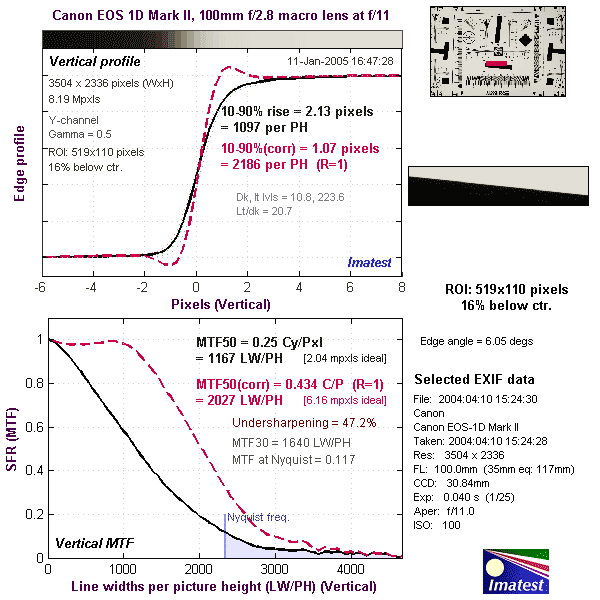
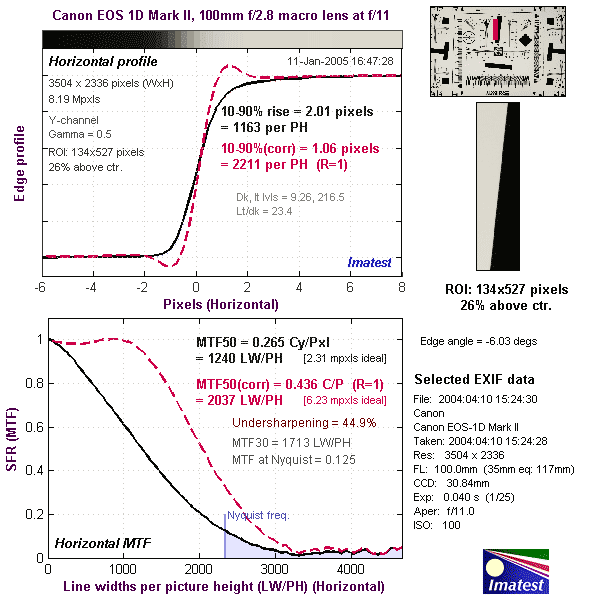
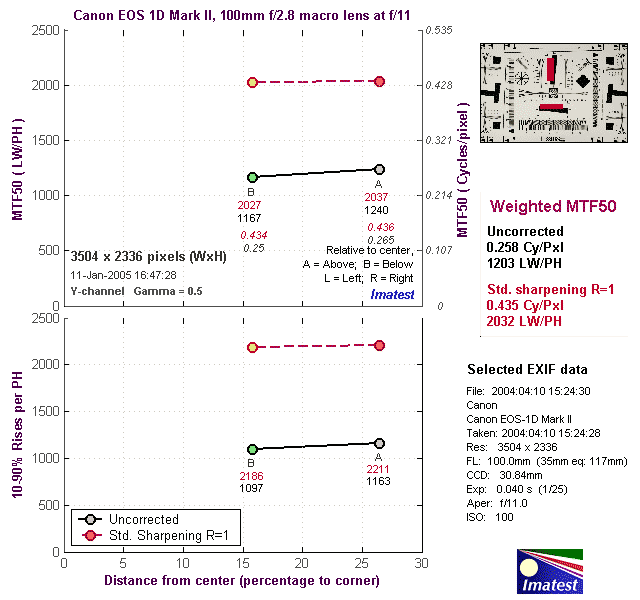

Follow Imaging Resource: